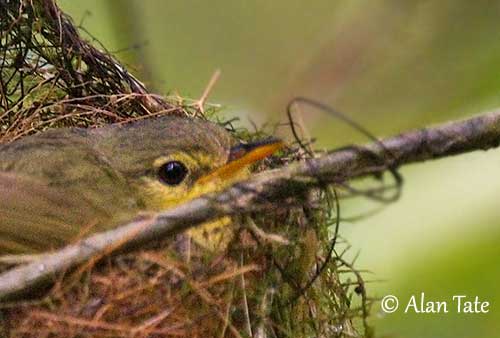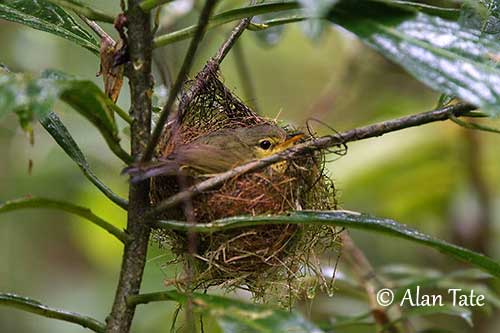
The Spectacled Tetraka is presumed sedentary.
It performs short flights while foraging. But the short, rounded wings and the fairly long tail do not allow sustained flight.
REPRODUCTION OF THIS SPECIES:
The Spectacled Tetraka breeds between September and December, especially in late dry and early wet season.
The nest is a deep cup made with thin stems and moss. The outer layer may be adorned with some dead leaves in order to make the nest almost invisible among the vegetation. The rim of the cup is attached to a horizontal fork in shrub.
The female lays 2-4 eggs of cryptic colour. The incubation lasts 16-19 days, apparently performed by the female. But both parents feed and rear the young that remain at nest during about two weeks. They still depend on parents for food for a few weeks after fledging.
PROTECTION / THREATS / STATUS:
The Spectacled Tetraka has large range and occurs in several protected areas. However, it is vulnerable to degradation, destruction and fragmentation of the forest. It is common throughout the range, especially below 1,200 metres of elevation.
The population is suspected to be declining due to habitat destruction.
The Spectacled Tetraka is not globally threatened and currently evaluated as Least Concern.
Fr: Bulbul à bec court
Ang: Spectacled Tetraka
All: Kurzschnabelbülbül
Esp: Bulbul Piquicorto
Ita: Bulverde dagli occhiali
Nd: Kortsnaveltetraka
Sd: glasögontetraka
Mal: Farifotra, Tetraka, tsintsina
Photographers:
Alan & Ann Tate
AA Bird Photography
Text bye Nicole Bouglouan
Sources :
HANDBOOK OF THE BIRDS OF THE WORLD Vol 10 by Josep del Hoyo-Andrew Elliott-David Christie - Lynx Edicions - ISBN: 8487334725
Birds of Madagascar and the Indian Ocean Islands Par Roger Safford, Adrian Skerrett, Frank Hawkins – ISBN: 1472924118, 9781472924117- Editeur: Bloomsbury Publishing, 2015
The Birds of Africa: Volume VIII: The Malagasy Region: Madagascar, Seychelles, Comoros, Mascarenes - Par Roger Safford, Frank Hawkins – ISBN: 1408190494, 9781408190494- Editeur: A&C Black, 2013
Wildlife of Madagascar par Ken Behrens,Keith Barnes - ISBN: 140088067X, 9781400880676 – Editeur: Princeton University Press, 2016
CREAGUS - MALAGASY WARBLERS Bernieridae
Fatbirder - Bernieridae - Malagasy Warblers
Wikipedia, the free encyclopaedia
Spectacled Tetraka
Xanthomixis zosterops
Passeriformes Order – Bernieridae Family
INTRODUCTION:
The Spectacled Tetraka is endemic to Madagascar. It occurs in N, E and SW of the island and frequents the primary evergreen forest. It feeds on invertebrates caught above ground level and forages actively among the vegetation.
This species was formerly placed in the family Pycnonotidae, alongside other Malagasy species, but they differ in voice and behaviour. The present species is placed in the genus Xanthomixis in the family Bernieridae, endemic to Madagascar. All these species are included in the Malagasy radiation of the Malagasy warblers.
The Spectacled Tetraka is described as generally common, but the population is declining due to habitat destruction.
DESCRIPTION OF THE BIRD:
Biometrics:
Length: 16 cm
Weight: M: 16-20 g – F: 13-22 g
The Spectacled Tetraka of nominate race has bright olive-green upperparts with darker wings and tail, mostly brownish-olive with yellow leading edges to flight-feathers.
On the underparts, chin and throat are bright yellow. Breast and flanks are olive-green whereas belly and undertail-coverts are yellow.
On the head, forehead, crown and nape are olive-green. We can see a yellow line extending from lores to the broken yellow eyering, forming yellow “spectacles”. The pre-ocular area below the lores is dark olive. The ear-coverts are paler olive-green. The malar area is bright yellow.
The bill has brown upper mandible with yellow cutting edge, or completely black. The lower mandible is pale brown, but it may be tinged yellow, orange or pinkish. The lower mandible is slightly inflated centrally. There are long rictal bristles around the base of the bill.

Male and female are similar, with slightly smaller female.
The juvenile has less distinct head pattern and duller throat.
SUBSPECIES AND RANGE:
The Spectacled Tetraka has two subspecies.
X.z. fulvescens is found in Montagne d’Ambre in N Madagascar. This race is paler and greyer above, and whiter (less yellow) below.
X.z. zosterops (described and displayed) occurs in E and SW Madagascar, and an isolated population is found at Analavelona.
HABITAT:
The Spectacled Tetraka frequents the rainforest from sea-level to 1,500 metres of elevation, but it is more common below 1,200 metres. However, it can be seen in second growths close to the primary undisturbed forest.
CALLS AND SONGS: SOUNDS BY XENO-CANTO
The Spectacled Tetraka produces loud, high-pitched, twittering sounds. The call is a squeaking, hoarse “tsit…tsit…tsit…” given when the bird is moving. We can also hear a spluttering “ptrrrrr”.
The song runs slightly up and down scale “ptrrrr…chich chich chich chich”.
BEHAVIOUR IN THE WILD:
The Spectacled Tetraka feeds on invertebrates, mainly arthropods such as Coleopteran, Isopteran, Dermopteran, Hemipteran, Hymenopteran, Orthopteran and spiders.
It forages above ground level up to 5 metres. It often perches on vertical stems of young trees and is very active while searching for prey. It performs short flights to catch flushed insects, and gleans in understorey, shrubs, creepers and ferns. It catches insects on the undersides of leaves by sally-gleaning.
The Spectacled Tetraka is gregarious and can be seen in groups of 20 individuals. It often joins other Bernieridae species and forms monospecific flocks. At dusk, it is generally seen in pairs, prior to roosting.
The breeding behaviour is poorly known. From two observations of three adults feeding a juvenile, this species may be a co-operative breeder, but more information is required.
Two nests were parasitized by the Madagascan Cuckoo.
The nest is cup-shaped and suspended in horizontal fork in shrub.
